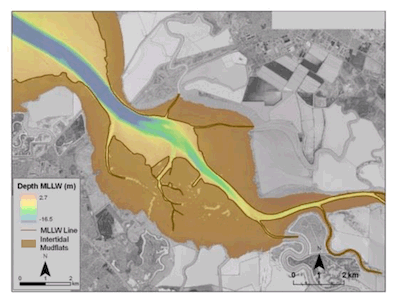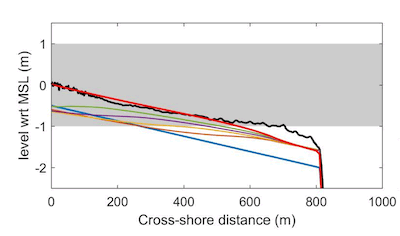M. van der Wegen 1,2, D. Roelvink 1,2,3, B.E. Jaffe4
1 IHE-Delft, This email address is being protected from spambots. You need JavaScript enabled to view it.
2 Deltares, This email address is being protected from spambots. You need JavaScript enabled to view it., 3 TU Delft
4 USGS, This email address is being protected from spambots. You need JavaScript enabled to view it.
Intertidal mudflats are key features sustaining a vital estuarine environment and protection of estuarine hinterlands against wave induced flooding. Their bed is shaped by hydrodynamic forcing of waves and tides, sediments and surrounding planform of channels, marshes (mangrove belts) and levee systems. It is essential to develop a better understanding on governing processes and forcing sensitivities to assess mudflat response to changing environmental conditions such as changing prevailing sediment concentrations, land reclamation works and sea level rise.
We developed an open source matlab code (MFlat) including an along-shore momentum equation, a cross-shore mass equation, the advection diffusion equation for sediment transport and a wave energy equation that allows for a straightforward computation of cross-shore mudflat morphodynamics, similar but less complex and more accessible than Delft3D. MFLat allows the inclusion of channels adjacent to the mudflat so that complex channel-shoal dynamics can be studied.
Model results show skill full development towards equilibrium cross-shore channel-mudflat profiles including both along-shore and cross-shore tidal flow. Similar to observations, the equilibrium mudflat bed show considerable sediment dynamics and large wave induced sediment concentrations during a tidal cycle, albeit that the tide residual effect is zero. In addition, we assessed the impact of extreme storm events and wave climatology on the equilibrium profile. The mudflat profile is remarkably resilient on changing wave forcing conditions. Observations show mainly erosion patterns at the edge of the channel-mudflat. The model shows similar patterns and recovery equilibrium conditions within 100 days after a 1 day extreme wave event. Wave climatology is imposed via the well-known mormerge approach (applied on sandy beaches), where multiple wave conditions are run in parallel on an evolving bed merging the impact of the multiple wave conditions. Preliminary modelling results show the impact of sea level rise on a variety of mudflat configurations, where mudflats react with inertia and slowly drown under all sea level rise scenarios.
Keywords:
Mudflats, wave climatology, estuarine morphodynamics, process-based modeling.


Figure 1. Location of modeled transect in South San Francisco Bay
Figure 2. Cross-section showing observed bed level (black) and morphodynamic development towards an equilibrium state after 100 years (colored lines).










